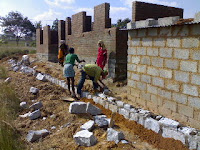The function of filling in plinth is to raise the height of the ground floor above the level of the outside ground with a view to prevent ingress of dampness in the ground floor. Under normal conditions the plinth is filled with excavated earth and finished with 15 cm thick layer of sand on top. This layer serves the base on which the layer of base concreate is laid. A plinth height of 45 cms is considered adequate for normal construction. Anti-termite treatement is done to the top surface of the plinth filling.

Curious to learn what these Termites were all about I did some reading over the net. Here are some notes.
Termites have been in existence for millions of years. They are capable of survival under most adverse conditions and environments. Termites are divided mainly into two types:
a) Dry wood termites
b) Subterranean termites
Dry wood termites live in the wood and do not maintain contact with the ground. They normally build nests within the dry timber members like door/window frames, wooden furniture etc. and destroy them gradually. They are however not as common as the subterranean termites and they cause lesser damage to the buildings.
Subterranean termites on the other hand are mainly responsible for causing damage to the buildings and its contents. Unlike dry-wood termites they live in soil and require moisture for their existence. They build underground nests or colonies and form mud-wall tunnels or runways which serve as protected shelters for their movements. Termites usually enter the buildings through foundations or cracks in masonry.
Termites eat materials like wood, grass,etc and also attack materials such as leather, plastics, rubber, furniture, clothings, stationary etc. keeping in view the enormous damage caused by the termites it is desirable to take suitable measures for preventing ingress of termites into the building.
The commonly adopted method of preventing attack of termites to buildings consists in treating the soil beneath the building and around the foundations with soil insecticides. This treatment serves to create a chemical barrier between the ground and the parts of the building in contact with the ground thereby preventing the termites from approaching or attacking.
The treatment is carried out right from the stage of initiating the construction activities for the building. This operation consists in poisioning the soil underneath the building and around the foundations of the building with insecticide solutions. DDT is commonly used in India for anti-termite treatment.


































